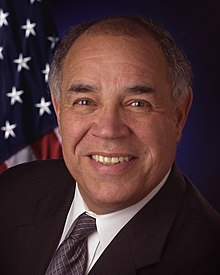NASA's first three Black astronauts were picked in January 1978 as part of the first Shuttle program group of 35 astronauts. NASA had expanded the criteria for this group: all previous astronauts had to be test pilots, meaning the pool for Mercury through Apollo (which expanded the rule just a bit to allow scientists, with geologist Harrison Schmidt reaching the moon on Apollo 17), consisted almost entirely of white males. The TFNG (Thirty-Five New Guys) also included the first American women.
The first Black astronaut to fly was Air Force pilot Guion Bluford in 1983. (I met him 15 years later, when he was a VP at engineering services firm NYMA. He was a reserved fellow, the kind who didn't need to command attention as astronauts (and, by legend, all military pilots), sometimes do. Physicist Ron McNair first flew in 1984 and died in the Challenger disaster in 1986. Air Force pilot Fred Gregory flew in 1985 and became become the first Black American to pilot, and later command, a space vehicle. He became the NASA Deputy Administrator, at one point serving two months as the Acting Administrator. A little-known fact is that he was the nephew of the famous physician, Dr. Charles Drew. Marine pilot Charles Bolden, selected in the next group in 1980, became the first permanent Black NASA Administrator. One other Black astronaut has given his life for exploration: payload commander Michael Anderson, another Air Force officer, was on the shuttle Columbia on February 1, 2003.
Major Robert Lawrence, picked in 1967 by the Air Force for the to-be-canceled Manned Orbiting Laboratory (MOL), would likely have transferred to NASA and eventually flown the Shuttle had he not died in a crash a few months after his selection.
Captain Edward Dwight, Jr. was an Air Force pilot added as a candidate in 1963 from outside the usual process – JFK himself picked him to integrate the program - but he was still in the test pilot qualification program when selected, and he never did make the cut for selection by NASA.
The first person of African descent to reach space was Afro-Cuban cosmonaut Arnaldo Tamayo Mendez, who flew on Russia's Soyuz 38, orbiting on September 18, 1980.
Photographs (Dwight and Lawrence photos USAF, others NASA)
Bluford, McNair, and Gregory in 1978
Bluford
http://www.jsc.nasa.gov/Bios/htmlbios/bluford-gs.html
Anderson
http://www.jsc.nasa.gov/Bios/htmlbios/anderson.html
McNair
https://www.jsc.nasa.gov/Bios/htmlbios/mcnair.html
Lawrence
https://www.amfcse.org/robert-h-lawrence-jr
Bolden (as NASA Administrator, 2009)
https://www.jsc.nasa.gov/Bios/htmlbios/bolden-cf.html
Gregory (as NASA Acting Administrator in 2005)
https://www.jsc.nasa.gov/Bios/htmlbios/gregory-fd.html
Dwight
https://www.smithsonianmag.com/history/ed-dwight-first-african-american-space-until-wasnt-180974215/
.









